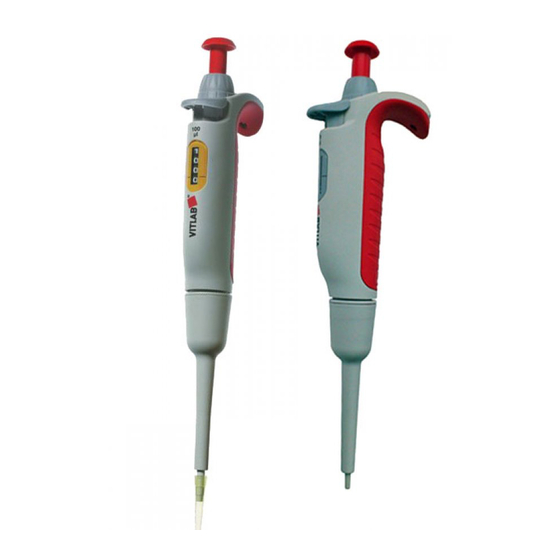Summary of Contents for Vitlab Micropipette
- Page 1 VITLAB ® micropipette Standard Operating Procedure (SOP) VITLAB GmbH Linus-Pauling-Str.1 63762 Grossostheim Germany tel: +49 6026 97799-0 fax: +49 6026 97799-30 info@vitlab.com www.vitlab.com...
-
Page 2: Table Of Contents
Table of contents 1. Introduction 2. Preparation of the pipette for testing 3. Test instruments and environment 4. Functional testing 5. Calibration - Checking the volume 6. Evaluation 7. Tables... -
Page 3: Introduction
These instructions may be used as a basis for the supervision of testing devices according to DIN EN ISO 9001, DIN EN ISO 10012 and DIN EN ISO / IEC 17025. Owing to its 8 respectively 12 channels, the VITLAB micropipette -8 / -12 can carry out 8 resp. 12 ®... -
Page 4: Preparation Of The Pipette For Testing
Read serial number (located behind tip ejection Enter number in test record button) ► Enter identification in test record Read customers identification, if present 2.2 Minimum configuration for VITLAB micropipette ® Have the operating manual ready ► VITLAB micropipette ®... - Page 5 2.4 Visual examination for damage or leakage Housing and tip ejector ► General damage? ► Piston Scratches or soilings on the surface? Seal ► Scratches or soilings on the surface? For multichannel pipettes: ► Scratches on the surface? Deformation? V- resp. O-rings damaged? Visual damage? ►...
-
Page 6: Test Instruments And Environment
3. Test instruments and environment Test room The calibration should be performed in a draught-free room with constant temperature and humidity. Temperature The test pipette and the test liquid must be at equilibrium with the room temperature. For this, leave the pipette (without the packaging) and the test liquid for at least 2 hours in the test room. Try to avoid temperature changes (e.g.from sun radiation). -
Page 7: Functional Testing
4. Functional testing Mount new pipette tip and set the nominal volume ► Aspiration of the liquid not possible or very slow: Take up the test liquid See notes in the table below ► Leak test: Hold the filled pipette If a drop forms: vertically for approx. -
Page 8: Calibration - Checking The Volume
≤ 50 µl Pipettes with nominal volume With pipettes of a nominal volume ≤ 50 µl, the error limits are usually smaller than 0.5 µl. Due to this small error limit, the evaporation of water during the test procedure has a relatively large influ- ence on the result. -
Page 9: Evaluation
7. Place weighing vessel on the balance and record weighing value. ► Enter value into test record. 8. Tare balance again. 9. Repeat steps 5 - 8 ten times (for multichannel pipettes ten times per channel). ► Enter weighing values into test record.This results in a minimum of 24 (8-channel) resp. 36 (12-channel) weighing values. - Page 10 Observe notes from the „Troubleshooting“ section in the operating manual ► Recalibrate the VITLAB micropipette according to the steps in the operating manual ® If these measures are not successful, we recommend you to make use of the VITLAB calibration service. Possible volume errors and the resulting measures: Error...
-
Page 11: Tables
7. Tables 7.1 Factor z - Excerpt from DIN EN ISO 8655, Part 6. Table refers to 1013 hPa. Valid from 950 hPa to 1040 hPa. Temperature Temperature Factor z Factor z ml / g °C °C ml / g 1.0035 1.0020 23.5... - Page 12 7.2 Volume error limits for piston operated pipettes The stated volume error limits for the VITLAB micropipette (Table 7.2.2) are final test values relative ® to the nominal capacity. These error limits refer to new instruments under optimised test conditions (qualified operators and standardised ambience conditions).
- Page 13 7.3 Volume error limits for multichannel piston operated pipettes The stated volume error limits for the VITLAB micropipette -8/-12 (Table 7.3.2) are final test values ® relative to the nominal capacity. These error limits refer to new instruments under optimised test con- ditions (qualified operators and standardised ambience conditions).
- Page 14 Test Record for Volumetric Instruments (EX) 1. Instrument: ® VITLAB continuous E / RS VITLAB genius ® VITLAB simplex ® Nominal volume: VITLAB TA ® Serial number: VITLAB micropipette ® Customers identification: 2. Damage: None 3. Functional defects: None Type of damage Type of functional defect: ..........
- Page 15 Test Record for Volumetric Instruments (EX) 1. Instrument: Type: VITLAB micropipette -8/-12 8-channel ® 12-channel Nominal volume: Serial number: Customers identification: 2. Damage: None 3. Functional defect: None Type of damage: Type of functional defect: ............................................
- Page 16 Testing volume: 50 %: ......µl Nominal volume: (mg) A(%) (nominal) CV(%) (nominal) Channel No. Weighing values (mg) (mg) (mg) (mg) (mg) (mg) (mg) (mg) (mg) (mg) X mean (mg) V mean (µl) A(%) found CV(%) found A(%) nominal CV(%)nominal Result A Result CV...
- Page 17 Test volume: Nominal volume: ....µl Nominal volume: (mg) A(%) (nominal) CV(%) (nominal) Channel No. Weighing values (mg) (mg) (mg) (mg) (mg) (mg) (mg) (mg) (mg) (mg) X mean (mg) V mean (µl) A(%) found CV(%) found A(%) nominal CV(%)nominal Result A Result CV The testing was carried out according to DIN EN ISO 8655.
- Page 18 Declaration on the Abscence of Health Hazards To be sent together with the instrument or via mail (if urgent with fax in advance). VITLAB GmbH Linus-Pauling-Str. 1 63762 Grossostheim Germany Fax: +49 (0) 6026 9 77 99 - 30 We intend to give our staff a maximum of protection from health hazards caused by contaminated instruments.






Need help?
Do you have a question about the Micropipette and is the answer not in the manual?
Questions and answers